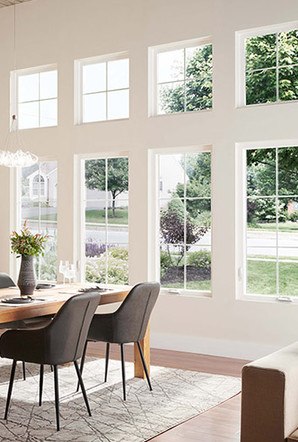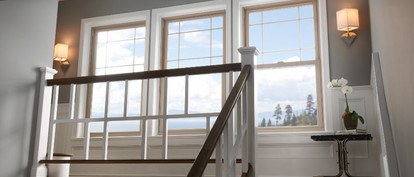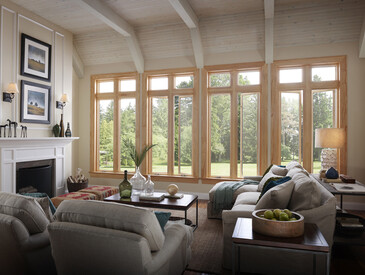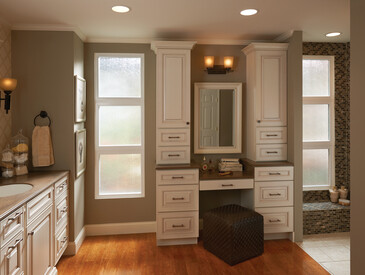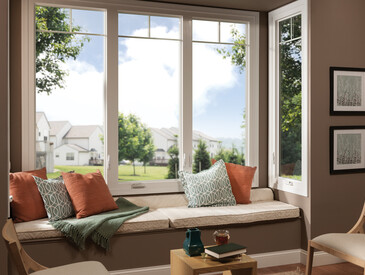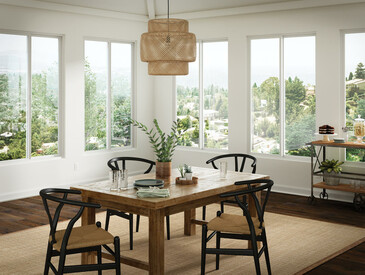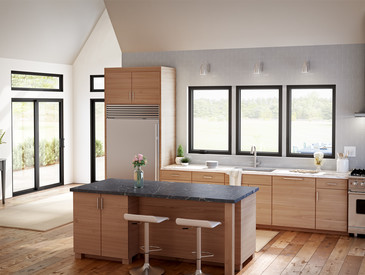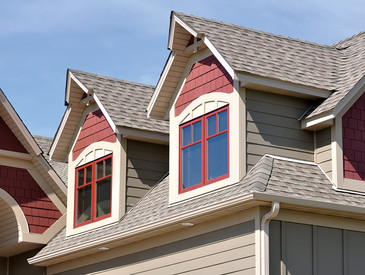A double hung window is a popular window style featuring two operable sashes that slide vertically. This design allows for versatile ventilation from the top, bottom, or both. Double hung windows complement many different architectural styles, including traditional, bungalow, cottage, Craftsman, colonial, and Victorian homes.
Double hung windows are highly customizable, with choices in frame materials, colors, finishes, and grid patterns. You can also opt for energy-efficient glazing and hardware styles to match your home’s aesthetic and functional needs. Their timeless look and practical features make them a favored choice for many homeowners.
Characteristics of Double Hung Windows
These double sash windows have several unique characteristics that differentiate them from other windows:
- Two operable sashes: Both the upper and lower sashes can move up and down. Cottage windows are a type of double hung window where the upper sash is smaller than the bottom sash. It’s usually a 40/60 split.
- Tilt-in feature: The ability to tilt both sashes inward is unique and enhances ease of cleaning.
- Versatility: Allows for more flexible ventilation options compared to casement or awning windows.
- Traditional aesthetic: Often used in traditional and historic home designs.
Operating the Tilt Sash Function
The tilt sash function is one of the most unique parts of a window. Operating the tilt sash function on Milgard double hung windows is easy. Follow these step-by-step instructions:
- To open the window, lift up the SmartTouch® lock and slide to open the bottom or top sash.
- Locate the two tilt latches on the top of the bottom sash.
- Slide the latches inward toward the center of the sash and pull towards you to disengage the sash from the frame.
- To operate the top sash, rotate the bottom sash downward until it rests against the bottom sill.
- Using the pull rail on the upper sash, pull downward until the bottom of the top sash is approximately 6” above the open bottom sash.
- Tilt the top sash inward. You may rest the top sash on top of the open lower sash.
- To re-engage the sashes with the jamb, rotate the upper sash until the tilt latches click back into the jamb track.
- Push the upper sash up until it stops in the closed position.
- The top sash must be fully seated in the sash pocket for the locks to engage properly.
- Rotate the bottom sash until both latches engage in the track.
Why Are Double Hung Windows Popular?
Whether you’re constructing a brand new home or need a window replacement, the double hung operating style is always a popular choice. The main benefits are:
- Maximum ventilation: The design allows for ventilation from the top, bottom, or both, improving airflow. Side-by-side double hung windows provide even more ventilation.
- Affordable cost: Double hung windows are usually one of the more cost-effective styles to purchase and install.
- Ease of cleaning: The sashes tilt inward, making it easy to clean windows on upper levels from inside your home.
- Slim profile: These windows do not protrude outward when opened, making them ideal for areas with limited exterior space like patios and walkways.
- Versatile design: They’re available in various materials, colors, and finishes to match different decor.
- Energy efficiency: They can be fitted with double or triple glazing for improved insulation.
Potential Drawbacks of Double Hung Windows
Many people love double hung windows, but there are a few drawbacks to consider:
- Cleaning and maintenance: Both sashes and tracks need regular cleaning and lubrication to ensure smooth operation.
- Potential for air leaks: While a double hung window replacement will reduce air leaks and improve energy efficiency, this style isn’t as airtight as casement windows or picture windows. However, you can fix this by using weatherstripping.
- Mechanical issues: The moving parts and locking mechanisms can wear out or break, requiring maintenance or replacement.
Are Double Hung Windows Right for Your Home?
Ultimately, every window style has its pros and cons – and all require regular maintenance to keep them fresh. Let’s compare double hung windows against a few other common operating styles to determine if they’re right for your home.
Double Hung Windows vs. Single Hung Windows
Instead of having two operable sashes, single hung windows have a fixed upper sash and an operable bottom sash. Ventilation is more limited with a single hung window because there is only one opening. It can also be challenging to clean the outside of the windows on the upper floors of your home since single hung windows don't have tilt sashes.
Here’s a side by side comparison for a quick review:

Double Hung Windows vs. Casement Windows
Casement windows provide more ventilation than double hung windows because the entire window is hinged at the side and opens outward. Casement windows also don’t have a rail in the middle of the window, so when they’re closed they look like a picture window and provide an unobstructed view. However, twin double hung windows with no grids provide a similar look as twin casement windows.
Double Hung Windows vs. Horizontal Sliders
Horizontal slider windows open with the sash sliding to the left or right, instead of up and down like double hung and single hung windows. You can choose from a single slider where one sash slides or a double slider, where both sashes open. They’re also one of the larger window styles, providing great air circulation and views.
Other Window Operating Styles to Consider
Now you know the answer to the question “What is a double hung window?” But there are many other options you can use in your home, including awning and picture windows.
Awning Windows
Awning windows are similar to casement windows but are hinged on the top instead of the side. These windows are generally smaller, offering less air ventilation than a double hung or casement window. But because of their design, you can leave them open in rain and snow, allowing air flow into your home while keeping out the weather and debris.
Picture Windows
For unobstructed views, picture windows are ideal. Picture windows are fixed windows that do not open, making them perfect for difficult-to-reach places that will benefit from a natural light source. However, be aware that they don’t provide any ventilation.
Explore Double Hung Windows and More
Now that you know what a double hung window is, it’s time to go shopping. Browse our wide selection of double hung windows to get started building your perfect product. Then connect with a MILGARD Certified Dealer in your area. Our Certified Dealers are trusted advisors when it comes to the window selection process and helping you decide which operating style is best for your project.













